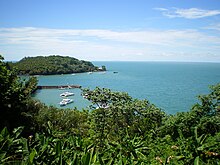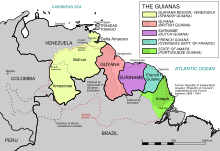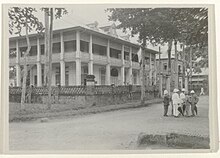
A | B | C | D | E | F | G | H | CH | I | J | K | L | M | N | O | P | Q | R | S | T | U | V | W | X | Y | Z | 0 | 1 | 2 | 3 | 4 | 5 | 6 | 7 | 8 | 9
This article may need to be rewritten to comply with Wikipedia's quality standards. (September 2022) |
French Guiana
| |
|---|---|
Overseas department, region and single territorial collectivity of France and outermost region of the European Union | |
| Territorial Collectivity of French Guiana Collectivité territoriale de Guyane (French) | |
| Motto(s): "Liberté, Égalité, Fraternité" (French) (English: "Liberty, Equality, Fraternity") "Fert Aurum Industria" (Latin) (English: "Work Creates Abundance") | |
| Anthem: La Marseillaise ("The Marseillaise") Chant du départ ("Song of Departure") [nb 1] | |
 | |
 | |
| Coordinates: 3°56′02″N 53°07′33″E / 3.9339°N 53.1258°E | |
| Country | |
| Prefecture | Cayenne |
| Departments | 1 (every overseas region consists of a department in itself) |
| Government | |
| • Prefect | Antoine Poussier[1] |
| • President of the Assembly | Gabriel Serville (Guyane Kontré pour avancer) |
| • Legislature | Assembly of French Guiana |
| Area | |
| • Total | 84,000 km2 (32,433 sq mi) |
| • Land | 83,534 km2 (32,253 sq mi) |
| • Water | 466 km2 (180 sq mi) |
| • Rank | 2nd region and 1st department |
| Population (January 2024)[5] | |
| • Total | 295,385 |
| • Density | 3.5/km2 (9.1/sq mi) |
| Demonym(s) | (French) Guianan (French) Guianese |
| GDP | |
| • Total | €4.58 billion |
| • Per capita | €16,600 |
| Time zone | UTC-3:00 (GFT) |
| ISO 3166 code | |
| Currency | Euro (€) (EUR) |
| Website | Territorial Collectivity Prefecture |
French Guiana (/ɡiˈɑːnə/ or /ɡiˈænə/; French: Guyane, [ɡɥijan] ; French Guianese Creole: Lagwiyann or Gwiyann, [la.ɡwi.jãn]) is an overseas department and region of France located on the northern coast of South America in the Guianas and the West Indies. Bordered by Suriname to the west and Brazil to the east and south, French Guiana covers a total area of 84,000 km2 (32,000 sq mi)[2][3][7] and a land area of 83,534 km2 (32,253 sq mi),[3] and is inhabited by 295,385 people.

French Guiana is the second-largest region of France (more than one-seventh the size of Metropolitan France) and the largest outermost region within the European Union. It has a very low population density, with only 3.6 inhabitants per square kilometre (9.3/sq mi). Half of its 295,385 inhabitants in 2024 lived in the metropolitan area of Cayenne, its capital. 98.9% of the land territory of French Guiana is covered by forests,[8] a large part of which is primeval rainforest. The Guiana Amazonian Park, which is the largest national park in the European Union,[9] covers 41% of French Guiana's territory.
Since December 2015, both the region and department have been ruled by a single assembly within the framework of a single territorial collectivity, the French Guiana Territorial Collectivity (French: collectivité territoriale de Guyane). This assembly, the French Guiana Assembly (French: assemblée de Guyane), replaced the former regional council and departmental council, which were disbanded. The French Guiana Assembly is in charge of regional and departmental government. Its president is Gabriel Serville.

Fully integrated in the French Republic since 1946, French Guiana is a part of the European Union, and its official currency is the euro. A large part of French Guiana's economy depends on jobs and businesses associated with the presence of the Guiana Space Centre, now the European Space Agency's primary launch site near the equator. As elsewhere in France, the official language is standard French, but each ethnic community has its own language, of which French Guianese Creole, a French-based creole language, is the most widely spoken. French Guiana is the only territory on the continental mainland of the Americas that is still under the sovereignty of a European state.
The border between French Guiana and Brazil is the longest land border that France shares with another country, as well as one of only two borders which France shares with non-European states, the other being the border with Suriname in the west.
Name

According to the Oxford English Dictionary, the name "Guyana" is an indigenous term meaning "land of many waters".[10] The addition of the adjective "French" in most languages other than French is rooted in colonial times, when five such colonies (The Guianas) had been named along the coast, subject to differing powers: namely (from west to east) Spanish Guiana (now Guayana Region in Venezuela), British Guiana (now Guyana), Dutch Guiana (now Suriname), French Guiana, and Portuguese Guiana (now Amapá in Brazil). French Guiana and the two larger countries to the north and west, Guyana and Suriname, are still often collectively referred to as "the Guianas" and constitute one large landmass known as the Guiana Shield.
History
French Guiana was originally inhabited by indigenous people: Kalina, Arawak, Galibi, Palikur, Teko, Wayampi and Wayana. The French attempted to create a colony there in the 16th century in conjunction with its settlement of some Caribbean islands, such as Guadeloupe and Saint-Domingue.
Prior to European colonization, the territory was originally inhabited by Native Americans, most speaking the Arawak language, of the Arawakan language family. The people identified as Lokono. The first French establishment is recorded in 1503, but France did not establish a durable presence until colonists founded Cayenne in 1643. Guiana was developed as a slave society, where planters imported Africans as enslaved labourers on large sugar and other plantations in such number as to increase the population. The system of slavery in French Guiana continued until the French Revolution, when the National Convention voted to abolish the French slave trade and slavery in France's overseas colonies in February 1794, months after enslaved Haitians had started a slave rebellion in the colony of Saint-Domingue. However, the 1794 decree was only implemented in Saint-Domingue, Guadeloupe and French Guiana, while the colonies of Senegal, Mauritius, Réunion, Martinique and French India resisted the imposition of these laws.[11]
Bill Marshall, Professor of Comparative Cultural Studies at the University of Stirling,[12] wrote of French Guiana's origins:
The first French effort to colonize Guiana, in 1763, failed utterly, as settlers were subject to high mortality given the numerous tropical diseases and harsh climate: all but 2,000 of the initial 12,000 settlers died.
After France ceded Louisiana to the United States in 1804, it developed Guiana as a penal colony, establishing a network of camps and penitentiaries along the coast where prisoners from metropolitan France were sentenced to forced labour.[not verified in body]
During operations as a penal colony beginning in the mid-19th century, the French government transported approximately 56,000 prisoners to Devil's Island. Fewer than 10% survived their sentence.[13]
Île du Diable (Devil's Island) was the site of a small prison facility, part of a larger penal system by the same name, which consisted of prisons on three islands and three larger prisons on the mainland. This was operated from 1852 to 1953.

In addition, in the late nineteenth century, France began requiring forced residencies by prisoners who survived their hard labour.[14] A Portuguese-British naval squadron took French Guiana for the Portuguese Empire in 1809. It was returned to France with the signing of the Treaty of Paris in 1814. Though Portugal returned the region to France, it kept a military presence until 1817.
After French Guiana was established as a penal colony, officials sometimes used convicts to catch butterflies. The sentences of the convicts were often long, and the prospect of employment very weak, so the convicts caught butterflies to sell in the international market, both for scientific purposes as well as general collecting.[15]
A border dispute with Brazil arose in the late 19th century over a vast area of jungle, resulting in the short-lived, pro-French, independent state of Counani in the disputed territory. There was some fighting among settlers. The dispute was resolved largely in favour of Brazil by the arbitration of the Swiss government.[16]
The territory of Inini consisted of most of the interior of French Guiana when it was created in 1930.[17] In 1936, Félix Éboué from Cayenne became the first black man to serve as governor in a French colony.[18][19]

During World War II and the fall of France to German forces, French Guiana became part of Vichy France. Guiana officially rallied to Free France on 16 March 1943.[20] It abandoned its colony status and once again became a French department on 19 March 1946.[21]
Following the French withdrawal from Vietnam in the 1950s and subsequent war between the Viet Cong and the United States, France helped resettle several hundred Hmong refugees from Laos to French Guiana during the 1970s and 80s, who were fleeing displacement after the communist takeover of Laos by Pathet Lao in 1975.[22][23]
In the late 1980s, more than 10,000 Surinamese refugees, mostly Maroons, arrived in French Guiana, fleeing the Surinamese Civil War.[22]
More recently, French Guiana has received large numbers of Brazilian and Haitian economic migrants.[22] Illegal and ecologically destructive gold mining by Brazilian garimpeiros is a chronic issue in the remote interior rain forest of French Guiana.[24][25] The region still faces such problems as illegal immigration, poorer infrastructure than mainland France, higher costs of living, higher levels of crime and more common social unrest.[26]
In 1964, French president Charles de Gaulle decided to construct a space-travel base in French Guiana. It was intended to replace the Sahara base in Algeria and stimulate economic growth in French Guiana. The department was considered suitable for the purpose because it is near the equator and has extensive access to the ocean as a buffer zone. The Guiana Space Centre, located a short distance along the coast from Kourou, has grown considerably since the initial launches of the Véronique rockets. It is now part of the European space industry and has had commercial success with such launches as the Ariane 4, Ariane 5 and Ariane flight VA256 which launched the James Webb Space Telescope into space.
The Guianese General Council officially adopted a departmental flag in 2010.[27] In a referendum that same year, French Guiana voted against autonomy.[28]
On 20 March 2017, French Guianese workers began going on strike and demonstrating for more resources and infrastructure.[29] 28 March 2017 was the day of the largest demonstration ever held in French Guiana.[30]
French Guiana has been severely affected by the COVID-19 outbreak, with more than 1% of French Guianese testing positive by the end of June 2020.[31]
Geography

French Guiana lies between latitudes 2° and 6° N, and longitudes 51° and 55° W. It consists of two main geographical regions: a coastal strip where the majority of the people live, and dense, near-inaccessible rainforest which gradually rises to the modest peaks of the Tumuc-Humac mountains along the Brazilian frontier. French Guiana's highest peak is Bellevue de l'Inini in Maripasoula (851 m, 2,792 ft). Other mountains include Mont Itoupé (826 m, 2,710 ft), Cottica Mountain (744 m, 2,441 ft), Pic Coudreau (711 m, 2,333 ft), and Kaw Mountain (337 m, 1,106 ft).
Several small islands are found off the coast: the three Salvation's Islands which include Devil's Island, and the isolated Îles du Connétable bird sanctuary further along the coast towards Brazil.
The Petit-Saut Dam, a hydroelectric dam in the north of French Guiana forms an artificial lake and provides hydroelectricity. There are many rivers in French Guiana, including the Waki River.
As of 2007[update], the Amazonian forest, located in the most remote part of the department, is protected as the Guiana Amazonian Park, one of the ten national parks of France. The territory of the park covers some 33,900 km2 (13,090 sq mi) upon the communes of Camopi, Maripasoula, Papaïchton, Saint-Élie and Saül.
Climate

French Guiana has an equatorial climate predominant.[32] Located within six degrees of the Equator and rising only to modest elevations, French Guiana is hot and oppressively humid all year round. During most of the year, rainfall across the country is heavy due to the presence of the Intertropical Convergence Zone and its powerful thunderstorm cells. In most parts of French Guiana, rainfall is always heavy especially from December to July – typically over 330 millimetres or 13 inches can be expected each month during this period throughout the department. Between August and November, the eastern half experiences a warm dry season with rainfall below 100 millimetres or 3.94 inches and average high temperatures above 30 °C (86 °F) occurring in September and October, causing eastern French Guiana to be classified as a tropical monsoon climate (Köppen Am); Saint-Laurent-du-Maroni in the west has a tropical rainforest climate (Af).
| Climate data for Cayenne (Köppen Am/Af) | |||||||||||||
|---|---|---|---|---|---|---|---|---|---|---|---|---|---|
| Month | Jan | Feb | Mar | Apr | May | Jun | Jul | Aug | Sep | Oct | Nov | Dec | Year |
| Record high °C (°F) | 32.5 (90.5) |
32.3 (90.1) |
32.2 (90.0) |
33.0 (91.4) |
33.2 (91.8) |
33.7 (92.7) |
34.5 (94.1) |
35.0 (95.0) |
35.2 (95.4) |
35.1 (95.2) |
34.6 (94.3) |
34.1 (93.4) |
35.2 (95.4) |
| Mean daily maximum °C (°F) | 29.1 (84.4) |
29.2 (84.6) |
29.6 (85.3) |
29.9 (85.8) |
29.9 (85.8) |
30.2 (86.4) |
30.8 (87.4) |
31.6 (88.9) |
32.1 (89.8) |
32.2 (90.0) |
31.5 (88.7) |
30.1 (86.2) |
30.5 (86.9) |
| Daily mean °C (°F) | 26.2 (79.2) |
26.3 (79.3) |
26.5 (79.7) |
26.8 (80.2) |
26.7 (80.1) |
26.6 (79.9) |
26.6 (79.9) |
27.0 (80.6) |
27.2 (81.0) |
27.3 (81.1) |
27.0 (80.6) |
26.6 (79.9) |
26.7 (80.1) |
| Mean daily minimum °C (°F) | 23.3 (73.9) |
23.4 (74.1) |
23.5 (74.3) |
23.7 (74.7) |
23.5 (74.3) |
22.9 (73.2) |
22.4 (72.3) |
22.4 (72.3) |
22.2 (72.0) |
22.3 (72.1) |
22.5 (72.5) |
23.1 (73.6) |
22.9 (73.2) |
| Record low °C (°F) | 17.4 (63.3) |
18.9 (66.0) |
18.5 (65.3) |
19.0 (66.2) |
18.8 (65.8) |
18.9 (66.0) |
19.0 (66.2) |
19.0 (66.2) |
18.7 (65.7) |
18.6 (65.5) |
17.2 (63.0) |
18.0 (64.4) |
17.2 (63.0) |
| Average rainfall mm (inches) | 451.2 (17.76) |
309.4 (12.18) |
334.3 (13.16) |
448.4 (17.65) |
579.4 (22.81) |
411.4 (16.20) |
245.7 (9.67) |
143.6 (5.65) |
55.7 (2.19) |
63.3 (2.49) |
133.4 (5.25) |
340.5 (13.41) |
3,516.3 (138.44) |
| Average rainy days (≥ 1.0 mm) | 23.6 | 20.0 | 20.7 | 22.2 | 26.4 | 25.2 | 20.6 | 14.2 | 7.1 | 7.6 | 11.9 | 21.6 | 221.1 |
| Average relative humidity (%) | 82 | 80 | 82 | 84 | 85 | 82 | 78 | 74 | 71 | 71 | 76 | 81 | 79 |
| Mean monthly sunshine hours | 95.1 | 92.4 | 120.0 | 123.5 | 122.4 | 150.4 | 200.5 | 234.4 | 253.4 | 256.4 | Zdroj:https://en.wikipedia.org?pojem=Administrative_divisions_of_French_Guiana|||

